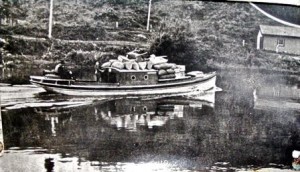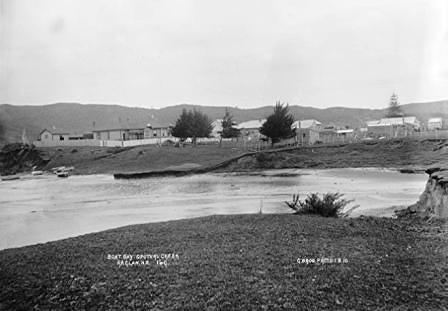By John Lawson

While 1913 was a big year for Raglan with improvements to the roads and the phone system, water transport was still important. Waingaro Landing wharf and shed were completed and a start made on Ruakiwi wharf, its shed and 17½ miles of road.
The tramway on the Long Wharf from Cliff St (opposite James St) was also still of concern; “At present the floor of the truck was on a level with the road, thus necessitating the lifting of goods the whole height of the waggon”. Council agreed improvements to the wharf tramway should “be put in hand almost at once.” They also agreed to increase their contribution to “the cost of establishing a ferry service to Te Akau to ₤7 10s, provided the Town Board contributed a similar amount.”
No progress was made with the proposed Raglan railway, but the Public Works Dept surveyed routes to Kawhia, including the Moerangi to Frankton route, which would have had a Raglan branch.
The Argus’s Raglan correspondent also reported on social and farming issues. The 27 February column used parentheses to report a visit by the Maori “king” and said his speech “was not very interesting to those who did not undertand the Maori tongue.” 600 or 700 natives were reported as greeting the king at Te Kopua (the 2006 Census showed the Raglan Māori population as 800).
In 1913 Dr Sanders moved to Frankton after 10 years in Raglan. He later returned, but for a while Raglan had no doctor. One hundred signed to join a medical club at ₤1 pa and, with help from the Hospital Board and the Native Department it was hoped to offer a new doctor ₤500 pa. A smallpox scare in Northland caused Dr Ross to visit, “vaccinating settlers and Maori.”
The minimum wage at Rutherford’s Te Aoterei flax mill (a 5km walk up the north beach) was reported as 11s 3d for a 10hr day. The return coach fare to Hamilton was 17/6. Three year old steers were sold for ₤13 a head. Farmers were paid about 1s a pound for butter.
The Winter Show on 23-4 May had a 42lb swede, button hole sewing, nail driving and many other events and competitions. Swedes and mangels grew well, milk was plentiful, butterfat prices up a third and wool prices high. The tennis and cricket clubs were reported as doing well financially and in their games with surrounding villages.

1913 seems to have been a good year for Raglan.

Do you have any information on the flax mill in Flax Cove? There is some basic information, but nothing of any detail, and no photographs? Thanks
Robyn
I don’t know of any photos and the written record is sketchy.
Chapter 46 of ‘Around Raglan’ says – Approaching Raglan, near the junction of Manukau and Main Roads, one sees a straight channel running out into Kaitoke Bay. George Rutherford, a brother of Sir Earnest, lived where Eric Cunningham now has his home. George built and operated a flax mill here, employing about 12 men. It was operated by a steam engine, parts of which still lie by the concrete pad on which it was mounted early this century.
The mill was built just above high water mark, so the flax could be brought in by punt or barge, and the muka or fibre later taken to the wharf by the same means. Walkways built each side of the barge would be used by 2 men. They would each thrust their poles down by the bow and slowly push the vessel along as they walked to the stern. This would be repeated until their destination was reached. The channel running out from this mill was dug by hand. George Rutherford also had a mill at Ruapuke and later bought Hall’s mill at Te Auterei. After the Raglan mill closed, the property was bought by N. D. Robertson, who lived here for many years while running the Hamilton – Raglan passenger transport service.
Papers Past has a few references –
Waikato Argus, Volume XV, Issue 6108, 5 December 1903, Page 2 – Mr Rutherford has recently put in another mill at Kaitoke Bay.
Waikato Times, Volume LIV, Issue 6331, 23 January 1904, Page 3 – Mr Rutherford, who has flax mills at Papanui, Pakoka and Te-ao-te-rei, is erecting another one on Kaitoke Bay, near to the township.
Auckland Star, Volume XXXVII, Issue 255, 1 November 1906, Page 3 – Mr Rutherford has sent two exhibits of dressed flax to the Christchurch Exhibition, weighing 1½ ton, from the Kaitoke mill at Raglan. The variety of flax is half “tihore” and half “ngauro”.
In 2012 a council paper for the proposed structure plan said, “Relocation of boiler and flywheel raises questions as to the integrity of the site and its heritage significance. Further research required to support listing. Date of construction not verified in report.”